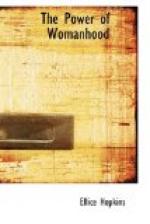You could go on further to illustrate the facts of reproduction by bees and ants, so familiar to children, where the drone or male bee, or the male ant, in just the same way as in the plant, fertilizes the eggs of the queen bee or ant by bringing the spermatozoa into contact with the unfertilized egg in the insect’s body, when the eggs thus fertilized are laid and carefully nurtured by the working bee or ant. All children have observed the little neuter,[19] or working ant, carrying in its mandibles an egg almost as large as itself with an air of extreme hurry and absorption, to lay it in the sun till the warmth hatches it into a baby ant.
If it were further pointed out that not the male, but the female, as the mother of the species, is Nature’s chief care; that among ants the male is sent into the world so imperfectly endowed that he cannot even feed himself, but is fed by his female relations, and that as soon as he has performed his function of fertilizing the queen ant, Nature apparently dismisses him with contemptuous starvation; or—to take the case of the drone or male bee—he is stung to death by the workers, it might help to modify the preposterous pretensions of the male, especially of the boy, in higher circles.
You could then pass upwards through fish with the soft and hard roe, or male and female elements which are familiar to children, and through frogs with their spawn to birds. Here comes in an upward step indeed. “A world that only cared for eggs becomes,” as Professor Drummond observes in his Ascent of Man, “a world that cares for its young.” The first faint trembling dawn, or at least shadowing forth, of a moral life, in the care of the strong for the weak, makes itself seen, which henceforth becomes as pervasive an element in Nature as the fierce struggle for existence in which the weak are destroyed by the strong.[20]
In the bird—till now “the free queen of the air,” living at her own wild will, suddenly fettered and brooding on her nest, and covering her helpless young with her tender wings—we see some faint image of the Divine tenderness. In the ceaseless toil of both the parent birds from morning till night to fill the little gaping throats we begin to feel the duty of the strong to serve and protect the weak; and in the little hen partridge, still clinging to her nest, when the flash of the scythe is drawing nearer and nearer, till reapers have told me they have feared the next sweep of the scythe might cut off her head, we see more than a shadow of that mother’s love which is stronger than death. And when we pass lastly to the highest order of animals, the mammalia, we find them named after the mother’s function of giving suck to her young from her own breast. They are no longer matured in an external egg, but are borne in her own body till they are able to breathe, and seek their nourishment from her, and then they are born so helpless that, as with kittens and puppies, they often cannot even see.




